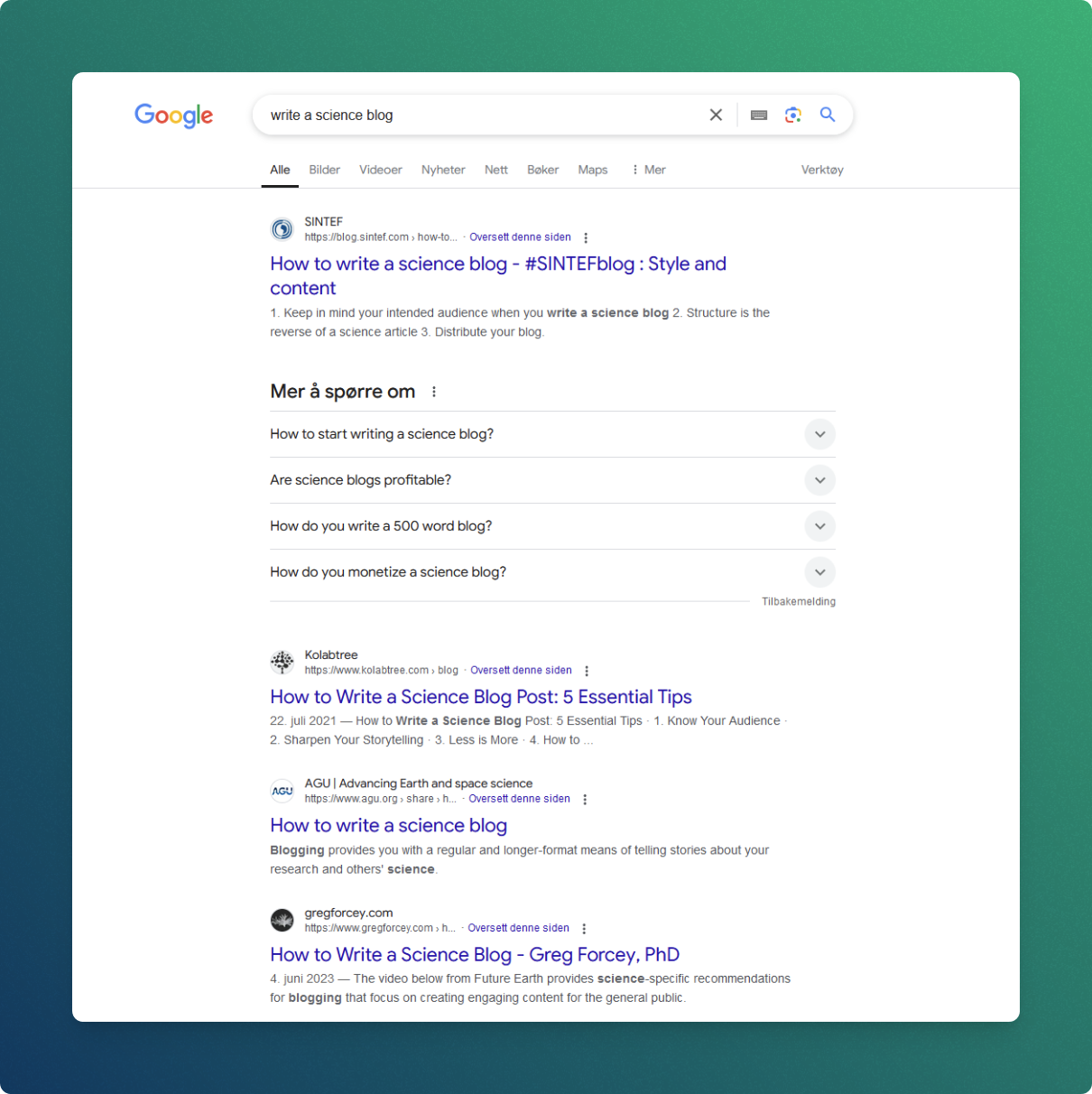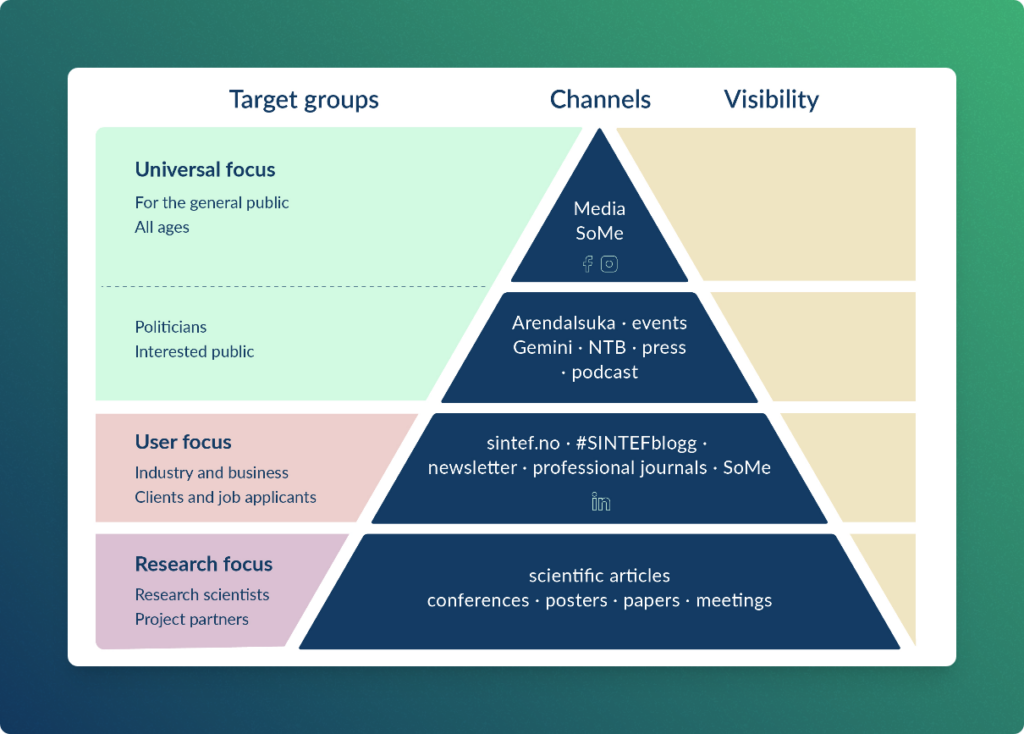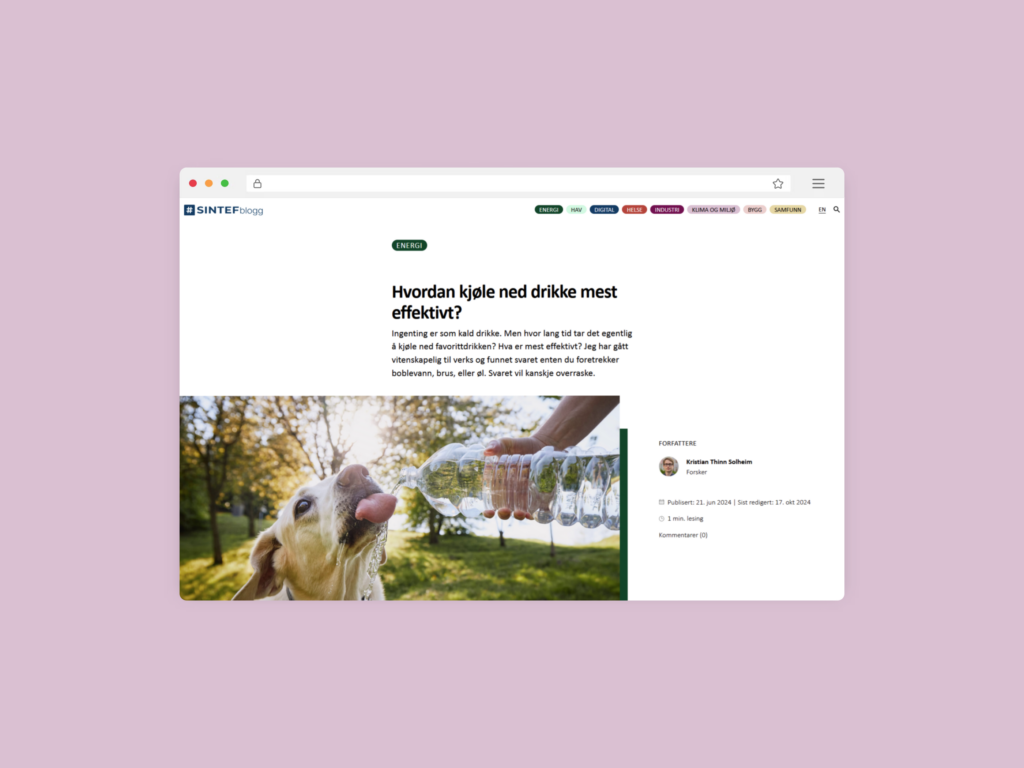Scientific blogging is a powerful tool for engaging with the public. In this era of fake news and disinformation, having a direct and reliable platform to share science-based information is more crucial than ever.
A blog post is a great way to highlight expertise or draw attention to a published report or scientific article. In this blog you will find some tips on how to write a science blog: Style and content.
Author: Anne Steenstrup-Duch (updated February 26, 2025).
A blog is the perfect platform for research scientists in all fields to capture the attention of potential industry partners, fellow academics, and individuals interested in new technologies. If you work for a research institute and want to share your findings through a blog, there’s no reason to wait. A blog can also be open to contributions from partners involved in various collaborative projects.
All you have to do is follow these easy steps to write a first draft. Don’t worry about perfection! The blog editors will help you add the finishing touches, and of course deal with the technical aspects of getting it published.
What should you write?
You tell us! Research results are great, but don’t feel limited to latest news. Other ideas include what it’s like to work in a specific lab, your experience collaborating with another research institute, a research-based opinion piece on a current news story or trending topic, a comment on current international research, etc. If you’ve just published a scientific article, there could be scope for a blog post too.

Consider something timely
You could also consider writing something timely. For example, this article on why you shouldn’t burn your Christmas tree in a wood stove performs well every January. This kind of applied science is perfect for the blog. It has mass appeal with the general public but could also appeal to journalists looking for a story, helping to get media mention.
Narrow it down
That being said, not every story needs to have mass appeal. Many of our hyper-focused technical blog posts perform very well in search engines. Writing a blog post is great way to connect yourself and your company to a specific topic, reaching research scientists and potential clients worldwide who may be searching for it.
Claim a niche
On that note, another great topic is something you’ve searched for on Google, but have been unable to find a good result. Your post could be that result for other people!

- Scientific results are good news! Have you and your colleagues recently published a scientific article?
- Do you want to highlight a new area of skills and expertise? You can blog about that!
- Do you want to comment on international research going on in your field? Why is this interesting in relation to your area of research?
- Recently started or interesting ongoing projects? Write about what you are working on and why.
- Science methods. Traditional news media are often not interested in methods, but descriptions can be interesting in a science blog. What methods have you used? How sure are you about your results?
- Working on a PhD? What’s it about?
- Have we been granted new laboratory facilities? Write about these and the opportunities they provide.
If you have an idea, don’t hesitate to reach out to the blog editors for help. Even if you don’t have an idea but want to blog, tell us about your research and we’ll help you come up with a story. Now there’s no excuses!
Who are you writing for? Content and style.
Before you open a blank document, consider who you want to read the post. Deciding this at the start helps you write a post with the most relevant content and in an appropriate style.
For example, if you’re targeting a broad audience, you’ll need to alter your everyday writing style. A good rule of thumb for writing more general text is to aim for a high school comprehension level. That means technical terminology should either be explained (if critical to the story) or a link provided to a readable background article (e.g. Wikipedia). It also means short, simple sentences. This is especially true when writing in English as almost half of our readers do not have English as their first language.
If you’re targeting the industry or other academics (in a different field than yours), you can allow yourself to be more technical. Imagine that you’re explaining your work to a smart relative who is not an academic. How would you speak then? Which details would you choose to include, and which ones would you skip? Remember that every acronym, technical word or new scientific concept you choose to write about requires effort on the part of your reader. It’s ok to impose to require your reader to make an effort, but do it too much and people might lose interest. It’s all about finding a balance between giving enough details to give an accurate overview of your research and overwhelming your readers with unnecessary information.

SINTEF-blog is ideal for audiences made up of researcher scientists and potential clients (technical and management) who have some knowledge of, or interest in, your research topics.
So, if you’re looking for some more inspiration, keep in mind our primary target audiences:
- Potential clients who are interested in our activities and want to know more about our research fields, and how we work.
- Research scientists and existing clients who have a particular interest in exactly what you are working on. Here, the blog should be written in English, and include a link to a scientific article that will provide a detailed description of your research work.
- Potential job seekers who are interested in finding out more about how we work.
We are also hoping to reach journalists who are interested in research material, politicians who are looking for examples of high-quality Norwegian research projects, and tech-interested audiences who have a general interest in technology and research.
A science blog is not a scientific publication: It should be about one thing
Don’t approach writing a blog in the same way as a scientific article or a research report. Keep your intended audience in mind throughout the writing process. The biggest difference when writing for a blog is in the style.
Blogs should be about one thing, and not a summary of an entire project. Background detail can be summarised in a single sentence and/or linked to, allowing you to quickly move on with the story.
That being said, this is not the same thing as dumbing down the story! Our target audiences are often looking for technical details. There’s no issue with including such detail when it is directly relevant to the story, just consider the audience first.
You can write about project meetings, but focus on something that was presented or discussed rather than the meeting itself.
Writing your draft
There’s no such thing as the perfect blog, so don’t spend hours mulling over a sentence. Get the first draft written and we’ll take a look and help you get it finished.
If you’re not sure how to get started, create a list of bullet points of things you want to cover. Next, turn each of those bullet points into one or two sentences, and you’re halfway there!
While you absolutely don’t need to cover all of these, here are some questions to help you get started:
- Exactly what is it that you have found out?
- Why is this research important, and why should my target audience be interested?
- What environmental benefits might this research bring?
- Will this research lead to more sustainable technology?
- Will it lead to less expensive and/or safer technology?
- What is your or your group’s contribution to this field internationally?
- What is needed for this technology to be applied/commercialised?
- Is this project relevant to others in the industry? Will it enable us to attract new clients and win new projects?
We publish many articles on our blog in both English and Norwegian. Stories of EU & international interest should be written in English first. We’ll then consider if it’s worthwhile producing a Norwegian version too. Of course, stories about projects or results that are only relevant to a Scandinavian audience should be written in Norwegian.
When writing in English, remember to consider the international nature of our audience. Try to avoid “Norwegianisms” including references to terms or concepts that only a native would understand.
How should a research blog be structured?
The blog editors will likely suggest a title that’s optimised for search engines. However, it’s a good idea to propose a working title before you start writing to keep your writing focused on that one thing.
Word count is flexible although between 500 and 2,000 words is preferred. Rather than aim for an arbitrary word count, use as many words as you need to tell the story in a succinct, structured way.
When you write the post itself, avoid the temptation to structure it like a scientific article! In fact, blog posts are often structured in reverse. The conclusion comes first! In general, introductions that aim to build up suspense simply don’t work on the web. Consider a popular news website. From the title, lede and first paragraph, a reader should know the who, what, when, where, why and how.

Links are important, both to external sources and to articles on your own company website and within the blog itself. You can refer to other blog posts that give more detail on a topic, or to webpages detailing expertise such as labs, for example. Link to sources within the text rather than creating a list at the end.
Photos and diagrams are very welcome. Also, be generous! Include credit where credit is due, for example by mentioning your colleagues and project partners. If including external partners, it’s a good idea to let them read the post first before publication.
Using AI to write your blog
The launch of ChatGPT in late 2022 led to large language models gaining popularity astonishingly quickly. People often dismiss them as “lying” or “hallucinating”. Indeed, delegating the entire process of writing your scientific blog to a language model is not advisable; but that’s missing the point.
Large language models – especially the premium versions which have a much higher number of parameters – can be fantastic writing partners. How often have you struggled with finding “the right word” when writing? With a language model, just write the incomplete sentence and ask the model to suggest several alternatives for the missing word.
You have writer’s block? Describe your topic to the model in a few sentences and ask it to suggest a structure for a scientific blog. It might just give you the inspiration to get you going.
Obviously, you should not share sensitive data with language models, and you should not trust their output blindly. But dismissing them entirely is saying no to an indefatigable, quick and reasonably skillfull writing partner.
A good picture tells a good story
A strong visual element can draw the reader in, evoke emotions, or explain something complex in a simple manner. How do we choose the right images?

Pictures and words are two distinct languages, each with their own strengths. A good blog article combines them in a balanced way. Visual elements – such as photos, videos, or illustrations – shouldn’t merely be seen as decorations, but as ways to support what you are trying to convey.
AI-generated images
In many companies, there are strict rules regarding the use of AI-generated images on their platforms. Many image generators are trained on data that may lack proper copyright clearance. All images must be clearly credited, and it is considered good practice to share the prompt. If relevant, the blog’s editorial team has access to tools and generators that ensure copyright compliance.


Finally: Share the blog!
Once the blog is published, share it with your colleagues and research partners. You can use email, and social media platforms like LinkedIn, ResearchGate and Facebook.
Good luck with your writing!

Assistance?
Do you work at SINTEF or are you a partner in a SINTEF project and want to blog? The SINTEFblog editorial team will help you with the final touches and, of course, take care of the technical aspects of publishing the blog.